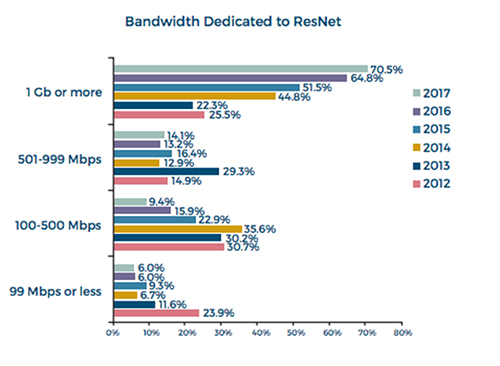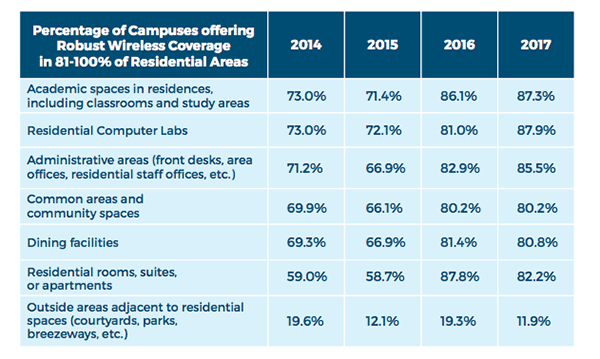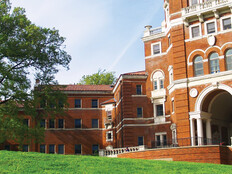3 Key Takeaways from the 2017 State of ResNet Report
The majority of college students try to connect at least two devices to their school’s network, the latest research from EDUCAUSE Center for Analysis and Research reports.
In an effort to keep up with the many student devices and academic tech demands, universities are making huge strides to provide adequate bandwidth on campuses.
The 2017 State of ResNet Report from the Association for College and University Technology Advancement and the Association of College and University Housing Officers-International takes a look at what devices are being used, what the biggest bandwidth consumers are and how universities are meeting connectivity demands.
1. Student Devices and Emerging Tech Battle for Connectivity
On college campuses, the ResNet report found that the top bandwidth-consuming devices are desktops and laptops, likely because they support video and other rich media.
“Desktops and laptops are seen as gateways to many disruptive applications that require excessive bandwidth,” the report states.
This year, smartphones surpassed tablets as the second most popular bandwidth user. In recent years, smartphones have seen more use as academic tools, with a Pearson survey finding 40 percent of college students wanting to use a mobile device for learning. EdTech has reported on the ability of smartphones to create flexible learning environments for multitasking students and provide access to information.
“I think it’s a great way to get students actively involved. Every classroom doesn’t have a computer or a set of tablets,” says Josh Murdock, an instructional designer at Valencia College, in the EdTech article.
The ResNet survey also found that one-fourth of universities anticipate drains on bandwidth from new devices like wearables and drones.
The Internet of Things was indicated by the ResNet report as an emerging area that would require collaboration between stakeholders and end users.
“Higher education institutions continue to evolve and improve upon ResNet and Wi-Fi practices as they now face the convergence of mobility, big data, advanced applications and even more devices,” reads the report.

SOURCE: 2017 State of ResNet Report
2. Student Entertainment Has a Big Impact on Bandwidth
Unsurprisingly, video platforms like Netflix eat the biggest percentage of campus Wi-Fi, followed by web-based rich content, music, video games and cloud content.
An infographic reports that nine in 10 American college students use Netflix, and 71 percent of them watch two to 10 hours of Netflix a week.
Classroom tools, however, aren’t eating up nearly as much.
“The digital learning environment (online learning tools and interactive digital textbooks) has a less significant impact on bandwidth demand when compared to entertainment applications,” the report says.
3. Universities Aim to Meet Connectivity Demands
Despite ever-increasing demands, universities are largely providing students what they want. More than 71 percent of institutions offer 1GB or more of bandwidth per student — which has increased threefold in the last 5 years. About one-fourth of campuses are offering a whopping 7GB or more of bandwidth.

SOURCE: 2017 State of ResNet Report
“Over the past five years of this study, bandwidth demand by students has been increasing, and bandwidth availability and the delivery to satisfy those demands have also increased,” states the report.
About half of colleges report that they have Wi-Fi throughout 81 to 100 percent of their campuses. Most college administrators believe high-performing internet is a key factor in attracting and retaining students, especially for on-campus housing, the report finds.

SOURCE: 2017 State of ResNet Report
So, how are they meeting this demand? It turns out there are many ways to address the demand in cost-effective ways.
The ResNet survey found that 61 percent of schools have a general tech fee that helps to pay for these services. At Cornell University, robust Wi-Fi is available —150GB per month — but if students go over that limit, they face a $1.54/GB fee, EdTech reports.
About 82 percent of schools with an in-house ResNet team are using bandwidth-management tools, but only 18.6 percent of schools are capping bandwidth usage.
For schools with more limited IT funds, capping bandwidth can be a cost-effective solution. EdTech reports on a program at Dallas Baptist University that caps student bandwidth at 10 MB.
“We saw an immediate increase in reliability and a lot fewer calls about performance issues,” says the university’s network operations director, William Gryder, in the article.









